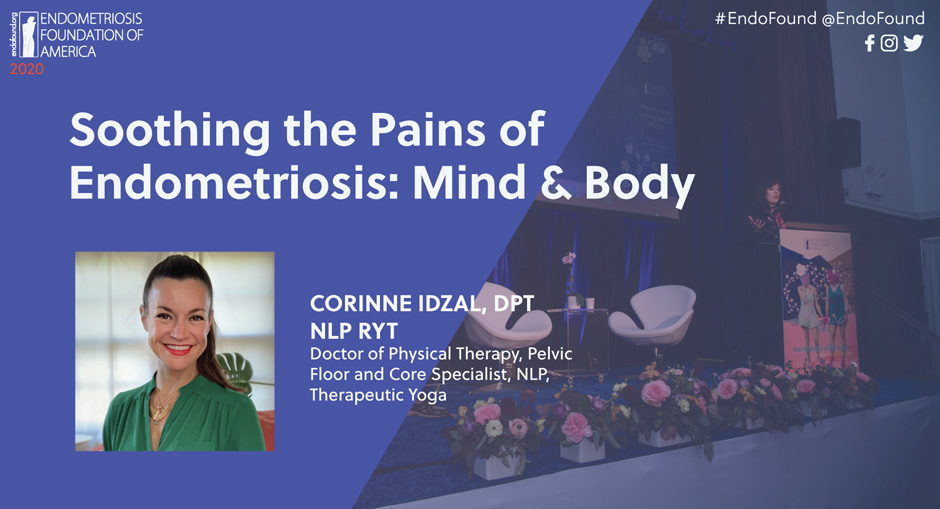Endometriosis Foundation of America
Virtual Patient Conference, October 16-18, 2020
Soothing the Pains of Endometriosis: Mind & Body - Corinne Idzal, DPT NLP RYT
Diana Falzone:
We have now a very special treat, because endometriosis impacts us in many ways, physically, mentally, and emotionally. Here today, we have Corinne Idzal, a doctor of physical therapy, a pelvic floor and core specialist, and she teaches multiple forms of yoga. Corinne joins us to discuss how to sooth the pain of endometriosis, mind and body. Welcome, Corinne.
Dr. Corinne Idzal:
Thank you so much, Diana, and hi everybody. I'm so happy to be joining you today. I'm very honored to be here, because I know that this issue is an issue that affects so many women, and I know that we still don't really have a great handle on the treatment. As you mentioned, Diana, and we've been talking about them on the forum last night, which was really interesting, and we will continue today. This issue is not, it's not simply about an organ and cells, right? This is an issue that affects the whole body. And not only that, given a lot of experience with not being diagnosed in time, a lot of frustration, not really feeling like you're being heard by the medical community, all of those experiences really lead to feeling a frustration and fear around the issue of endometriosis. It really is not just as simple as doing exercises or taking a pill. This is a whole body experience.
It's not just the pain, it's the fear of the pain that can be just as overwhelming and just as debilitating as the pain itself. There's a good reason for that, because fear of pain creates tension in the body. Your body is always listening to your thoughts and to what your brain is experiencing, and so the act of being in fear, the state of being in fear affects us physically, and that physical tension increases our pain. It increases the sensitivity in the area as well. You will be hearing more about this tomorrow in [Dr. Pain's 00:00:02:42] coping with pain in the brain, but the experience of pain is not just in the body part. This is an experience that we have in the brain as well.
So for that we want to, any kind of treatment will not just address the physical component, but a really successful treatment, in my opinion, addresses the physical, the psychological, and the mental component. All three together, because we are whole beings, right? So addressing this pain cycle that we get trapped in where the fear increases the pain, and then when we have more pain, it is oh so hard not to be afraid, right? So this vicious cycle is one that we really want to break, and that's where I come in. My therapy, as you mentioned, Diana, I'm not just a doctor of physical therapy, but I specialize in core and pelvic floor treatments and yoga, and neuro-linguistic programming, which is the study of our thoughts and the words that we use and how that affects our physical experience.
So with any kind of treatment, when people come to me with endometriosis, I always start with a soothing technique, right? People don't need right away exercise. What you need really is to soothe the body, and in soothing the body, reconnecting with the body. So my first technique that I'd like to teach you guys is exactly that, right? So the main problem that we have with, one of the problems we have. I don't want to say the main, but what I help people to address is the tension. It's the stress, it's the fear. Because in releasing the fear, you release the physical tension that we hold onto as well. So in this experience of chronic pain, it can feel like we're powerless. Like the pain comes to us when it wants to, and almost as if our bodies and the experience our body is having is separate from ourself.
This is a form of dissociation. But when we dissociate, or we think of our body as our enemy, or feel like we don't have power, that is what makes the situation worse. When the truth is, we have so much more power than we think we do. We may not have the power to change our current condition, but we always in the moment have the power to feel a little better, or to feel a little worse. Those moment by moment decisions, to feel a little better or to feel a little worse, those add up to our path each of those little steps. So what we're really looking for, besides the broader picture of really looking for a cure and looking for something that will end this, but what you can do, what we can do, our only true power is to feel a little better right now. And if you can get a handle on that, get a handle on soothing yourself, it's amazing the effect that has on the experience of pain.
Because we can have pain and be in fear and anxiety. We can have pain with the understanding that it's going to be okay and we're safe, even though this is happening. Those two experiences are dramatically different. It's a dramatically different experience in the brain, which means it's a dramatically different experience in your body. So we want to, even though it is so understandable to have the fear, to be anxious and nervous and not want it to come back and afraid. Is that it? Is that not it? Do I feel it? All of that is normal, but that doesn't mean that it's not making it worse. Right? So what we want to do is try to find a way to soothe ourselves from the inside. So that is a technique that I'm going to teach you guys now. It's one of the techniques. I teach my patients to get a handle on chronic pain, and that is the first step to getting a handle on the condition, is to just try to feel a little more soothed in the moment. That really is our power.
So I'm going to have you guys do this with me. All right. So make yourselves a little bit more comfortable than you are, right? You might even kick off your shoes, and I'm going to have you put your hands on your belly, down low, and close your eyes. We're just going to start with some nice, slow, low breaths. And by low, I mean inhale way low in the belly, and then long exhale, relax. So on the inhale, the belly expands, and on the exhale, the belly sinks in. It might take about four to five breaths. After about four to five breaths, you should start to feel a little more relaxed. When you feel that, you know you've shifted your nervous system to rest and repose. That's the first step. So looking to relax and calm. On the next exhale, I want you to make your body a little bit more heavy. You're sinking down into your seat. It's not all at once. It's little by little. Long exhale. If you want to shift position and become more comfortable, do that.
Now you'll start talking to your body. Take a deep breath in and on the exhale, just say, "It's okay. It's okay. It's okay. It's okay, you're safe." Tell your body what it needs to hear. Feel it through your hands. Long exhale. You're okay. It's okay. You're okay. It's going to be okay. On your next inhale, make it even bigger and feel the stretch across the belly, and then the long exhale. Once you have done that for a few minutes and you feel a little bit better, might open your eyes, and you would probably feel that even in that short amount of time, you feel a little different. You feel a little more calm on the inside. That is your power. That's what we have. That's all we have. We're looking for peace and calm. Even in the midst of pain in the storm, it is possible.
That is the best, most powerful tool you have is your breath. It will, in a matter of minutes, shift you from a stressed, fearful state to a calm state. You have to use your words to. Many of us are used to telling our story. We're used to fighting the pain and hating the pain, and that's understandable. But as long as the focus is the pain, the pain has the power. In the moment that you are fighting the pain, you can, with practice, instead shift to find the relief. Try to find the soothing, try to find your breath, and from there doing some movement. I would say definitely after a session of breathing, you want to move your body, because with this fear and the attention to one certain area of the body, that creates energetic imbalance. So after you've breathed a little bit and you feel a little bit better, that's when you want to get up and move, just some stretches. It doesn't have to be fancy, but just opening and releasing.
You want to curl in and open up. If you do that a few times, like a cat-cow in a seated position, you might start to feel a little shaky. You might start to feel a little nervous or zingy, right? That's the energy evening itself out. Some shaking and some moving. But I really wanted to give you guys that one message, and it is that we are far more powerful than we think we are. Maybe not to control conditions, but to control way we feel and to shift our focus, and to just try, just try to make ourselves feel a little bit better. I hope this was helpful. It was such an honor to speak with you guys today. I know that we're going to have some questions, so I look forward to that.
Diana Falzone:
All right. Thank you, Corinne. I told you earlier that I can't meditate, that every time I tried to do yoga or mindful meditation, I'm the one in the class like, "What's going on?" But I was surprised that when you were telling us to be mindful of our breath and to pay attention, I almost fell asleep. I'm sure it's common, right? Did I just achieve ultimate relaxation that quickly?
Dr. Corinne Idzal:
Especially in this situation, that's very impressive.
Diana Falzone:
Right, right. We're in a virtual patient conference, and I'm falling asleep from relaxing.
Dr. Corinne Idzal:
Well, the key, Diana is it is the breath, but we take it for granted. We often think, "I'm going to take a deep breath." So we take a deep chest breath, but that doesn't help. You have to take a breath down in the belly where we breathe when we're relaxed and when we're safe. And by the way, we're born breathing in the belly. This is how we're supposed to breathe all the time.
Diana Falzone:
Yeah, no, that's an excellent note. And we do have some questions for you, so I want to get to them. Speaking of the belly, we have [Alicia Landis 00:16:25]. She said, "How long each day should we do this belly exercise?"
Dr. Corinne Idzal:
What a great question. I would say a minimum of five minutes a day, and it's a great way to start the day. So I would say put that in your morning routine, because ultimately what we're looking for, yes, this is so powerful in the moment. But if you do it every day, it shifts your overall setting to be more calm in general, which is really what we want. So put it in your routine, your morning routine. Five minutes, deep, slow belly breathing, talking to yourself, talking to your body, connecting. If you're not connected, if we're waging war, the war will never, ever end. We have to connect. So that technique of talking to your body, saying what you need to hear as if you were talking to your best friend. Also, you can do that throughout the day. Whenever you feel stressed, whenever you feel anxious or angry, and also it's great to do at night when you can't sleep. If you wake up in the middle of the night, this'll get you back to sleep. It's just such a great tool.
Diana Falzone:
When you mentioned about waging war with your body, and then you mentioned your body being your best friend, I know for myself with my personal journey with endo, there have been times where I feel so disconnected from my psyche and from my body. I just feel like my body is attacking me. It's almost like you just want out of your own body just to escape the pain. I think almost like, I don't know if you would call it biofeedback or what the correct term is, but telling your mind you're in line. This is your ally. This isn't your enemy. That message is very powerful. It resonated with me.
Dr. Corinne Idzal:
So glad. You're right. It's a defense mechanism, right? We're not taught to connect with our bodies. So when we start to have these experiences, it is, it's our defense mechanism to try to separate in some way. But that doesn't work. It actually makes the problem so much worse for the very reason that that creates tension, that "Oh no." The tension just adds to the feedback loop of pain. So it's completely understandable, and it's a strategy. It makes sense why we do that, but there is another way. There is another way that feels better, and it will, the irony of it, will in the long run have long-term beneficial effects, more than the fighting. Being more relaxed, being less stressed, that helps every system of the body. It soothes the immune system, the digestive system, everything. All of those systems that play a huge part in the experience of endometriosis.
Diana Falzone:
Right. We have another question from Amanda. "Can you explain pelvic floor exercises?" This is a good one. I've done pelvic floor physical therapy after my surgeries, and I found it to be very, very helpful for sciatic pain and also just in general pelvic floor issues.
Dr. Corinne Idzal:
Yeah, yeah. Well, yeah. So pelvic floor exercises, here is the ... It's a bigger subject than just a one sentence, but here's why the pelvic floor exercises helped you with your sciatica, because the pelvic floor is part of the core. That is why I identify myself as a core and pelvic floor specialist, because you can't address the pelvic floor without the entire core system that it's a part of. So when we do pelvic floor exercises, which is a very simplified version of the Kegel, which is a squeeze and pull up. Also though, the release, right? It's not just about getting the Kegel. For most people with endometriosis, that's a broad statement. For many people with endometriosis, the problem is not getting the squeeze necessarily, it's getting the release.
Dr. Corinne Idzal:
Because if you're stuck in a squeeze, you can't squeeze more, but that causes pain when you try. So the first thing you have to do is relax the muscle, and this is the first step I taught to you. You have to relax the muscle first, and then retrain it to contract and relax at the right time. It's a very, incredibly important system. It is key to our physical stability, and it is also key to our mental stability. Because first, if we're structurally unsound in the skeletal system, it's upsetting to the brain. The brain has to compensate in other ways, using the wrong muscles, and that causes a whole, whole slew of imbalance in the body, physical imbalance. But also that we use the pelvic floor to breathe. When you're doing this breathing, you're relaxing the pelvic floor. As you're doing the relaxing breathing, you're relaxing the pelvic floor. But I guess a very simplified answer to the question, can you explain pelvic floor exercises, that's really it. It's first identifying, is the muscle weak or is it spastic? Understand that. You can't just give a blanket exercise.
Diana Falzone:
And when you say spastic, that's tense, correct?
Dr. Corinne Idzal:
Yep. Exactly.
Diana Falzone:
I've heard that from fellow endo sisters, that it's the tense. Yeah.
Dr. Corinne Idzal:
You don't just start doing the squeezes. So I want to first, where are we starting? So from there, if it's spastic, the next step is soothing, and if it's weak, then the next step is getting the brain to find the muscle again. And that's the first step.
Diana Falzone:
Yeah. There's a lot of components to it, and I so appreciate you going through one of the tenets, the foundation of breathing, and breathing the way that we were trained, as you said, to breathe in the womb, not that nervous energy breathing. It was very, very informative and insightful, and thank you. I'm sorry to all of those that we couldn't get your questions, but as you know, we will be addressing questions at a later date. So thank you again, Corinne. It was awesome.
Dr. Corinne Idzal:
It was such an honor to be here, and stay safe, everyone. It was so great to connect with you guys.
Diana Falzone:
Thank you.










